 |
|
Here and There introduces art, artists, galleries, museums, and other cultural facilities around Japan that non-Japanese readers and first-time visitors may find of particular interest.
|
|
 |
|
|
 |
 |
Specter over the Capital: Makoto Aida at Mizuma Art Gallery
Alan Gleason |
 |
View from the gallery entrance of Monument for Nothing V - Japanese Matsuri (2019), wood, wire, cotton thread, Japanese paper, wood glue, acrylic. Photo by Kei Miyajima |
If one word describes Makoto Aida's work, it is "subversive." The artist has made a name for himself with impishly perverse, politically ambiguous, expectation-sabotaging pieces that never fail to confound his critics and delight his fans. So it is no surprise that his solo show at Tokyo's Mizuma Art Gallery aims straight at the concurrent Tokyo Olympics -- but with what sort of message, it's hard to say. Several at once, it seems.
The Mizuma show is a compact installation of just a few thematically linked pieces. The ambiguity begins with its title, given in English as "I can't stop the patriotism". Japan's patriotism, or his own? Well, probably both. One of Aida's favorite tricks is to inflate a balloon of anticipation and then burst it preemptively, and his title accomplishes that too. The phrase turns out to be a play on an utterly apolitical hit from the early eighties, "I Can't Stop the Loneliness," by J-pop megastar Anri. Even the English translation is a bit misleading, because the original Japanese song title literally means "The sadness doesn't stop." Likewise, the Japanese title of the Aida show, Aikokushin ga tomaranai, translates as "The patriotism doesn't stop" -- whose patriotism, it doesn't say.
Aida has always flaunted the complexity of his feelings about his home country and its fraught history, particularly its past military adventures, as well as recent attempts in political circles to whitewash same. His oeuvre often toys with symbols of Japan at war; one iconic painting shows a squadron of Zero fighters flying in an infinite loop over a burning New York City, in what could be construed as a revenge-fantasy allusion to the U.S. firebombings that killed so many civilians in Japanese cities. (The work can be seen in this Here and There review of a 2013 Aida retrospective.) But he also lampoons the jingoism of the wartime era and of contemporary politicians: another notorious work is a video Aida made several years ago in which he did a spot-on impersonation of what he describes as "a man calling himself Japan's Prime Minister making a speech at an international assembly."
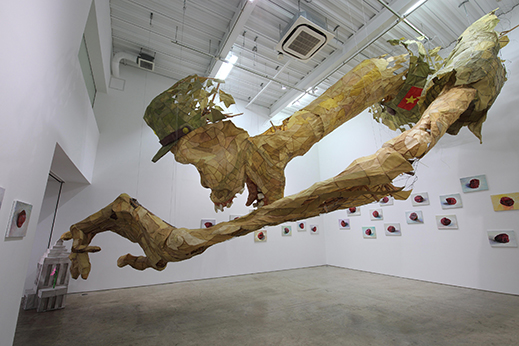 |
|
Installation view, Aida Makoto "I can't stop the patriotism" at Mizuma Art Gallery, showing the Nebuta-style construction of Monument for Nothing V - Japanese Matsuri (2019) from the side. Photo by Kei Miyajima |
The Mizuma show combines several works that address these issues of history and nationalism with varying degrees of irreverence, and like the title, their overall purport seems intentionally inscrutable. Entering the main gallery -- a large, high-ceilinged white cube -- one immediately comes face-to-face with a monstrous apparition: the hideously gaunt, bucktoothed, bug-eyed visage of a starving Japanese soldier in ragged uniform, swooping down dragon-like from the ceiling, one bony finger outstretched to tap . . . a silly papier-mâché mockup of Japan's National Diet Building. Next to the terrifying specter of the soldier, the gray, windowless, meter-high edifice appears frivolous and pathetic; one is reminded of the tiny Stonehenge stage prop of Spinal Tap fame. To add to the absurdity, two cartoon flowers, yellow and pink, stick out of the wings on either side of the Diet cupola, evoking nothing so much as a traditional Japanese gravestone -- which is, of course, precisely the idea.
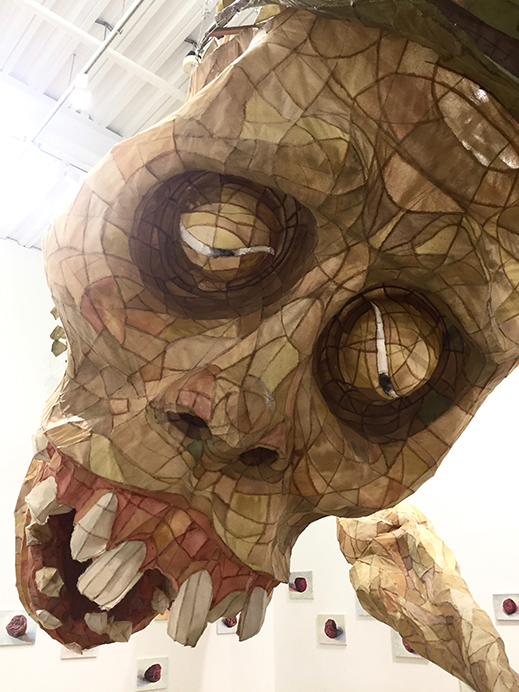 |
|
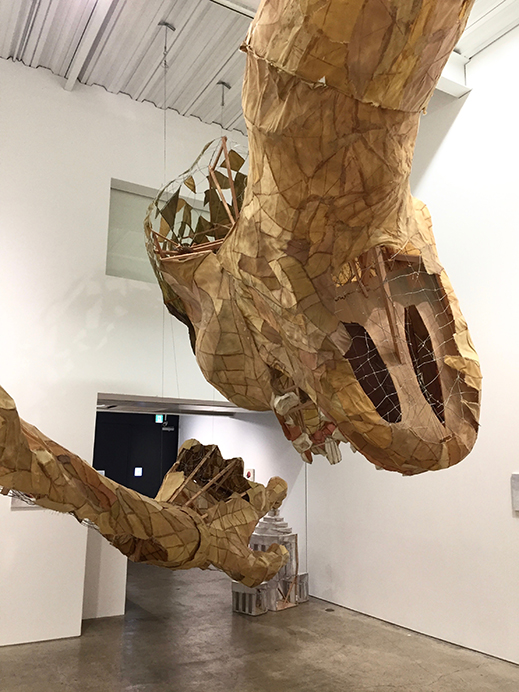 |
|
|
|
Close-ups of the head from the front (left) and rear (right), Monument for Nothing V - Japanese Matsuri (2019). Photos by Alan Gleason |
The effigy of the soldier "putting the finger" on Japan's parliament is the latest in a series that Aida has added to over the years. Its title, Monument for Nothing, gives some idea of Aida's general take on war and nation. This latest installment, Monument for Nothing V, is subtitled Japanese Matsuri (i.e. "Festival"), referencing the fact that the soldier figure is built in the manner of one of the famous illuminated floats of northern Japan's Nebuta Festival. These giant constructions of washi paper glued over wood-and-wire frames typically feature legendary warriors in full regalia, so the skeletal soldier would appear to be Aida's update of that tradition as well.
Installation view, Umeboshi (2020-2021), acrylic and oil on canvas. Photo by Alan Gleason |
Festooning the walls surrounding this installation are nearly fifty small oil paintings of the same motif: umeboshi, the "pickled plum" (actually an apricot) that is a staple of the Japanese diet. The artist states that he painted his Umeboshi series as an homage to Tofu, an 1877 work by Yuichi Takahashi that Aida considers "the first and finest oil painting in Japan." Like tofu, he declares, umeboshi is a food "favored exclusively by the Japanese people, and considerably misunderstood by foreigners." As a foreigner who happens to like umeboshi a lot, I would dispute that assumption, but Aida has always been prone to pronouncements that smack of Japanese exceptionalism -- yet another element of his performative persona as conflicted patriot.
Indeed, what makes these ruddy, mouth-puckeringly sour little spheres such an attractive motif for Aida, and for this show in particular, is the fact that when framed against a rectangular white background, they look a heck of a lot like a rising sun. And so the starving soldier's ghost is surrounded by images reminiscent of both the national flag and the national food, one that was a standard part of army field rations during the war.
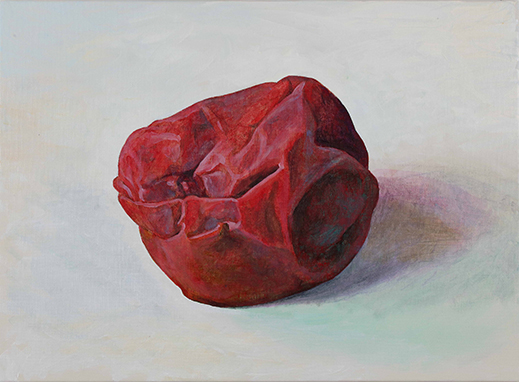 |
|
Umeboshi (2021), acrylic and oil on canvas. Photo by Kei Miyajima |
Aida initially prepared Monument for Nothing V and the Umeboshi series for a show scheduled for last summer, which was postponed to this year so as to coincide with the similarly postponed games. In the meantime he added another piece that resonates thematically with the others, but seems to be entirely in good fun. The title alone is nearly the size of the tiny side-gallery that houses it: A Statement of Protest from Nukazuke, Which Came in Last Place in the Northeast Asian Pickles Championship as the Representative of Japan. The championship is of course a figment of Aida's imagination. Nukazuke, another arguably "exclusive" Japanese dish, consists of vegetables fermented in rice bran. The installation is a send-up of competitions that pit the nations of northeast Asia against each other in rivalries whose ferocity clearly owes something to the war that ended 76 years ago. Here the premise is that Japan's entry in the pickle sweepstakes was relegated to a bronze medal behind China's silver-winning Szechuan pickles, with the gold captured by a joint North-South Korean entry -- what else but kimchi? A large glossy color photo depicts the three contestants on the podium. To this unforgivable loss, "Nukazuke" itself has responded with a written complaint to the judges, citing its own sublime "purity" and "simplicity" as reasons why it should be recognized as "the supreme pickled vegetable of Northeast Asia -- and the world!" This protest appears on the gallery walls in English, Japanese, Chinese and Korean. The English version, like the others, is handwritten vertically in sumi ink, no mean feat in itself.
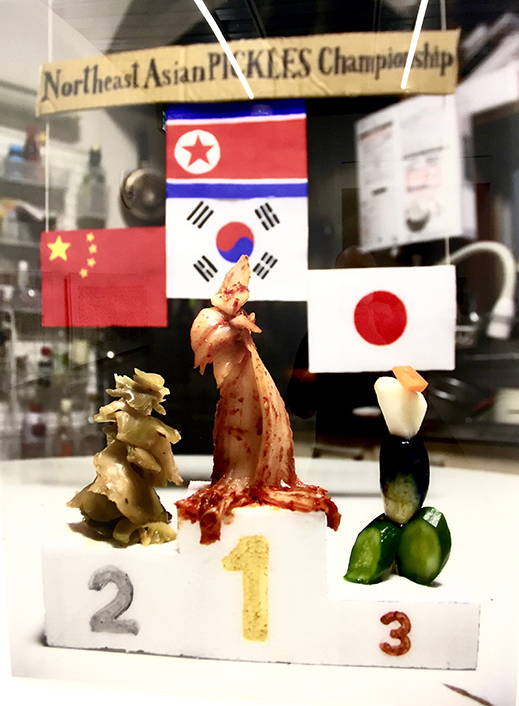 |
|
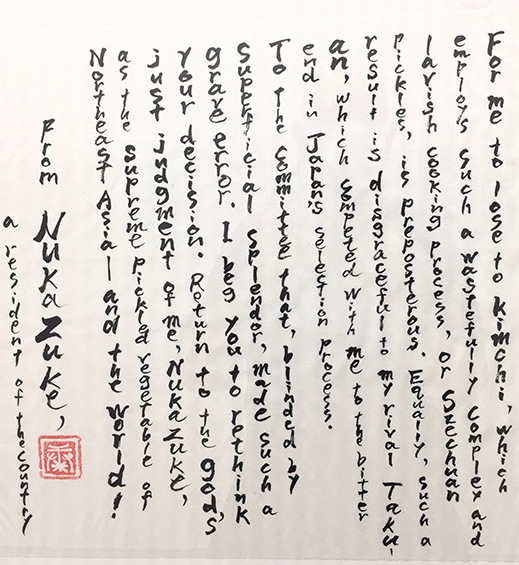 |
|
|
|
Left: Photograph (lambda print). Right: Conclusion of the English version of statements in four languages, sumi ink on Japanese paper. In A Statement of Protest from Nukazuke, Which Came in Last Place in the Northeast Asian Pickles Championship as the Representative of Japan (2020-2021). Photos by Alan Gleason |
Considering all the fun Aida pokes at Japan's peculiar brand of cultural nationalism, it is surprising that right-wing demonstrators have not congregated to demand the closure of this and his other exhibitions. Though labeled as "anti-Japanese" by some denizens of the Internet, he seems to have escaped the wrath recently directed at the After "Freedom of Expression?" exhibition, which featured a sculpture of a young Korean "comfort woman," one of many forced into sex slavery for the Japanese army, and a film in which an image of Emperor Hirohito is burnt to ashes. Initially cancelled at the 2019 Aiichi Triennale due to bomb and arson threats, the show suffered a similar fate at successive venues in Nagoya and Tokyo this year before finally completing a three-day run in Osaka thanks to a court order and a robust police presence. Why do the rightists seem uninterested in Aida's gibes? My guess is that his wit simply goes over their heads. Or perhaps they think that a gallery-ful of rising-sun umeboshi is, after all, the mark of a true patriot.
"I can't stop the patriotism" is not Aida's only contribution to the summer's COVID-shadowed festivities. As part of the Olympic-timed Pavilion Tokyo show of outdoor installations scattered around the capital, he has erected two Japanese castles -- one of cardboard and one of blue plastic sheeting -- flanking the entrance to Meiji Jingu Park, site of the Olympic Stadium. They will greet visitors to the park until 5 September.
All works © Makoto Aida; images courtesy or by permission of Mizuma Art Gallery. |
 |
| Aida Makoto "I can't stop the patriotism" |
| 7 July - 28 August 2021 |
| Mizuma Art Gallery Tokyo |
2F Kagura Bldg., 3-13 Ichigaya-tamachi, Shinjuku-ku, Tokyo
Phone: 03-3268-2500
Hours: 11 a.m. - 7 p.m.
Closed Sundays, Mondays, and national holidays
Access: 5 minutes' walk from Tokyo Metro Ichigaya Station, exit 5 (Yurakucho and Nanboku Lines); 8 minutes' walk from JR Iidabashi Station, west exit (Sobu Line)
|
|
|
|
| |
 |
Alan Gleason
Alan Gleason is a translator, editor and writer based in Tokyo, where he has lived for over 30 years. Since 2006 he has edited artscape Japan and written the Here and There column, as well as translating the Picks reviews. He also edits and translates works on Japanese architecture, music, and theater. |
|
|
|
|
|
|
|
|
|
 |
|